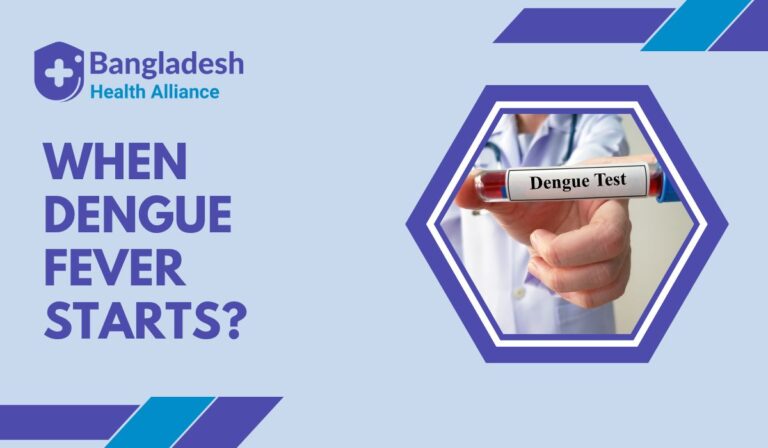Dengue fever, a formidable adversary in the realm of infectious diseases, stages its entrance with a temporal cadence that often catches individuals unawares. In this comprehensive exploration by the Bangladesh Health Alliance, we illuminate the intricacies of dengue fever’s onset, shedding light on when and how this viral ailment commences its dramatic performance.
Unraveling the Timelines of Dengue Fever: The Prelude of Onset
The incubation period for dengue fever, which is the time between being bitten by an infected mosquito and the onset of symptoms, typically ranges from 4 to 10 days, with an average of around 4 to 7 days. However, symptoms can appear as early as 3 days after exposure or as late as 14 days.
It’s important to note that not everyone who is infected with the dengue virus will develop symptoms. Some individuals may have a mild or asymptomatic infection and may not realize they have been infected. When symptoms do occur, they often start suddenly and can include high fever, severe headache, joint and muscle pain, and other flu-like symptoms.
If you suspect you have been exposed to dengue virus and start experiencing symptoms within the typical incubation period, it’s advisable to seek medical attention for proper diagnosis and care. Early detection and management can help prevent complications and ensure a smoother recovery.
The Prologue: Dengue Virus Takes the Stage
At the heart of dengue fever’s chronicle is the dengue virus, an enigmatic member of the Flaviviridae family. A quartet of serotypes – DEN-1, DEN-2, DEN-3, and DEN-4 – orchestrates this viral symphony. Each serotype is capable of inducing dengue fever, each with its distinctive nuances.
The Symphony of Onset: Dengue Fever Emerges
The opening act of dengue fever unfolds with a dramatic flourish, introducing an array of symptoms that often materialize 4 to 10 days after a mosquito bearing the virus delivers its infectious payload. This latency period, known as the incubation period, is the temporal space during which the virus percolates within the human host.
Curtains Rise on the Febrile Phase:
- Fever’s Flourish: The inaugural symptom, akin to a crescendo, is the sudden surge of high fever. The temperature scale often ascends to 104°F (40°C) or beyond, signaling the virus’s orchestration within the body.
Symphonic Phases of Dengue Fever’s Progression:
- Critical Crescendo: As the viral symphony progresses, some individuals may transition into a more critical phase marked by complications, such as dengue hemorrhagic fever (DHF) and dengue shock syndrome (DSS). These severe manifestations often emerge around the third to seventh day of illness.
A Composition of Recovery and Convalescence:
- Recovery Refrain: Gradually, the fever subsides, offering a respite from its fiery embrace. The recovery phase commences, characterized by a gradual return to normalcy.
The Pivotal Role of Vigilance
Recognizing the onset of dengue fever requires keen vigilance, especially during periods of heightened dengue activity. Early detection of symptoms, such as high fever, severe headache, joint and muscle pain, and pain behind the eyes, is instrumental in timely medical intervention and effective management.
Harmonizing Prevention: A Prelude to Wellness
In a realm where dengue’s viral overture remains without a targeted antiviral treatment, prevention takes center stage:
- Mosquito Mitigation: Eliminate potential breeding sites by eradicating stagnant water sources.
- Personal Shield: Utilize mosquito nets and repellents to shield against bites.
- Defensive Attire: Adorn protective clothing to minimize skin exposure.
- Community Cadence: Foster community awareness and engagement in mosquito control efforts.
In summation, dengue fever’s onset is a dance orchestrated by the dengue virus, with symptoms typically emerging 4 to 10 days after an infected mosquito’s bite. Recognizing this temporal tapestry equips individuals with the insight needed to navigate the terrain of dengue fever and take proactive steps toward protection and well-being.
References:


